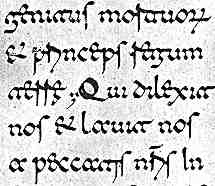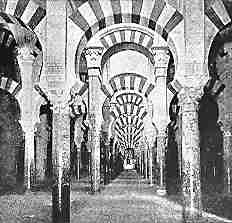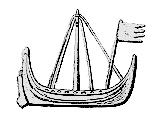






If you are looking at this page without frames, there is more information about medieval writing to be found by going to the home page (framed) or the site map (no frames).
| Post-Roman Scripts (3) | ||||||
| Intricate study of pre-Carolingian and Carolingian manuscripts makes the whole concept of National Hands seem inappropriate. Writing was not a national type of activity, but was thinly dotted about in centres of literacy all over Europe. The interaction between these centres did not revolve around national issues, but depended on the spread of monastic culture, the borrowing of books and the teaching of writing between centres of influence. | ||||||
| See Bischoff 1994 for a discussion, and if you want to work it out for youself, battle through the multiple volumes of Lowe (ed) 1936-1966. | ||||||
| Bischoff identifes a range of what he calls writing provinces from the age of Charlemagne. These are areas based around important writing centres, where particularities of interaction and influence had produced a certain recognisable style before the adoption of the uniformity of Caroline minuscule. These provinces are spread across France, Belgium, the Netherlands, Germany and Italy and owe their characteristics to the specific historical interactions which took place within them. | ||||||
| This map shows the Carolingian writing provinces according to Bischoff. | ||||||
| It is notable that some of the most distinctive and longlived preCarolingian scripts were produced in areas at the periphery of the whole area. The insular scripts were developed and survived in England and Ireland, lasting the longest in Ireland, the most westerly extremity of Latin literate culture. Visigothic script was produced in the southwestern extremity of the region in Spain. Beneventan developed from Lombardic into a distinctive script in its own right in southern Italy. | ||||||
 |
||||||
| Segment from a Sacramentary of St Gall (St Gall, Cod. 348) from the late 8th or early 9th century. (From Thompson 1912) | ||||||
| The above example of an early northern Italian style of script has certain features which were later to be identified with the Beneventan script of southern Italy. The first words, Sacrificium tibi, show three of them; an open a written like a double c, a t with a loop on its back and a ligatured ri. Thompson calls this "incipient Lombardic", preferring to reserve the term Lombardic for the later script of the south, now generally referred to as Beneventan. This usage turns the name Lombardic into historical nonsense, as the full development of the script postdates defeat by the Franks of the Lombards in the north of Italy. It just becomes a label. | ||||||
 |
Sample from a late 11th century lectionary from Montecassino (Monte Cassino, Cod. xcix). (From Thompson 1912) | |||||
| This later example, from the heart of Beneventan territory, shows all the features of the first, as well as the tall, loopy e and the angular penmanship with heavy oblique strokes which gives the Beneventan script its unique character. | ||||||
| While the southern part of Italy was developing a script with unique qualities which was to survive for many centuries, the northern areas were subject to a range of influences from around the Frankish empire and even beyond. Irish scribes in the monastery of Bobbio, for example, brought their own script which influenced the writing style from that area. | ||||||
 |
||||||
| Segment from a 7th century text of St Ambrosius on the Holy Spirit from the abbey of Bobbio (Milan, Biblioteca Ambrosiana, D.268, parte inferiore, f. 6v). (From Steffens 1929) | ||||||
| In the above example, the script switches abruptly from an insular half uncial to an antique Italian style of script; multicultural monasticism. | ||||||
| Thompson has discussed the diversity of forms of handwriting to which the label Merovingian was applied. He regarded the archetypal script of this class as that produced by the Merovingian royal chancery, and tended to class the range of book hands produced across the whole area as Franco-Lombardic. Bischoff has discarded the classificatory terminology of Merovingian, Germanic and Lombardic altogether and embarked on an intricate historical analysis of the relationships between centres of writing. He attempts, from the scanty survival of datable 8th and 9th century manuscript books, to identify the particular characteristics of the scripts of significant centres of writing such as Tours, Paris, Metz, Lyons and many others. | ||||||
 |
The Muslim conquest of most of Spain caused an emigration of literate clergy to monastic institutions and writing centres further north. The writing styles of the south of France and Burgundy were influenced by Visigothic minuscule as a consequence. | |||||
| Interior of the 8th century mosque at Cordova, Spain. | ||||||
| Saracen raids up the great rivers of France penetrated into the far interior. The monastery of Luxueil was destroyed, and with it the highly distinctive and mannered Luxeuil minuscule. The abbey had revived by the later 8th century, but not the distinctive script. | ||||||
| Viking raids on northeast France may also have played some part in an unintended exchange of cultural information. The abbey of Corbie, near Amiens, is believed to have received books from monasteries threatened or destroyed by Viking attacks. Books displaying a range of scripts have been associated with this institution. |
 |
|||||
| While these swashbuckling big events of the era played their part, transmission of styles also took quieter paths. Books were borrowed between institutions for copying. The church was a thinly dispersed international elite of experts. Individuals or communities travelled or were transplanted to distant locations. Modern studies on the paleography of this era is less absorbed with devising classifications and more concerned with the development of detailed chronologies and paths of influence. | ||||||
| An interesting gap in Bischoff's map of the writing provinces is Rome and its surrounds. Not that they had stopped writing there, but they evidently retained a conservative writing culture based on the continuing use of uncial script for ordinary book hand, not just for fancy display volumes. Unfortunately for those protagonists of Rome as the centre of the cultural universe from Classical to Renaissance times, it apparently played little part in the development of the new minuscule scripts that would culminate in the clarity, elegance and uniformity of Caroline minuscule. | ||||||
 |
A reconstruction of the ancient basilica of St Peter's, pulled down during the "Classical revival" of the Renaissance, as architecturally conservative then as the book hands of Rome in the 8th century. | |||||
| The development of regional styles was a process which could produce a fair amount of individual variation. Script styles were experimental in this era. The work of an individual scribe could have unique features. | ||||||
 |
Segment from a hymn from a codex of around 761 from St Gall (St Gall, Stiftsbibliothek, Kodex 2). (From Steffens 1929) | |||||
| The above sample of Merovingan minuscule book hand was written by a known scribe, Winitharius, who had a distinctive hand and was polite enough to add colophons with his name in them to some of his works. Bischoff describes his hand as coarse, somewhat inflexible and not typical of other scripts from Alemannia, the writing province of which St Gall was one of the main centres. The gradual development towards Caroline minuscule did not obliterate regional or individual differences of style, but it made them more subtle and contained them within a more general culture of mutual legibility. | ||||||
|
|
||||||
|
|
||||||
|
|
||||||
|
If you are looking at this page without frames, there is more information about medieval writing to be found by going to the home page (framed) or the site map (no frames). |
||||||